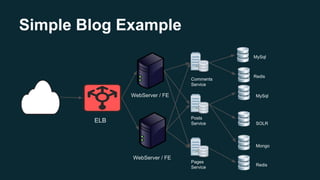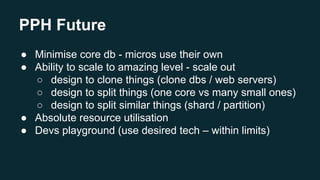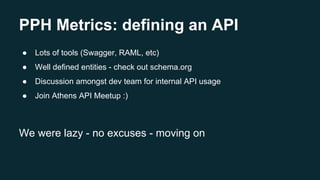introduction to micro services
- 1. Micro Services Intro & implementation of a microservices architecture Docker Athens Spyros Lambrinidis @slambrinidis CTO 18 Feb 2014 Panagiotis Moustafellos @pmoust DevOps
- 2. What is a MicroService “approach to developing a single application as a suite of small services” “designing software applications as suites of independently deployable services”
- 3. What is a MicroService
- 4. What is a MicroService ● Each service is loosely coupled / independently deployable ○ Changes made only to this service ● Each service has a bounded context ○ Service should not know about surrounding service (domain driven design)
- 5. Characteristics ● Services ● Products vs Projects ● Smart endpoints / dumb pipes ● Decentralized governance ● Decentralised data management ● Automation ● Design for failure ● Evolutionary design
- 6. Simple Blog Example ELB WebServer / FE WebServer / FE Comments Service Pages Service Posts Service Redis MySql MySql Mongo Redis SOLR
- 7. Advantages ● Small code base / easier to test / maintain ● Easy to scale - clone ● Easy to throw away ● Easy to deploy and track errors ● Freedom to switch tech stack ● Maximise team agility ● Maximise resource utilisation
- 8. Disadvantages ● Devops challenge on multiple fronts ● Complexity in messaging and front end ● Most container technologies still new ● Freedom of tech stack not always good news (for the future and for the CTO)
- 9. Micro Service and agility ● Modern agile practice can not ignore tech ● No modern tech = no absolute agility ● Micro services enable agility in a special way ○ Enforce team creation ○ Enforce faster deployments / better & easier tests ○ CI / CD ○ Easier communication flow methods (APIs) ○ Each service = small scale product
- 10. Container Technology in micros ● Containers assist micro architecture in ○ Visualising services ○ Building / sharing services between coders ○ Deploying services ○ Utilising server resources to run containers irrespective of underlying tech ● Popular container technologies ○ Docker ○ Rocket
- 11. Container Management ● Used to maintain and utilize containers / services ○ Make sure all services up and running ○ Make sure server utilisation is maxed out ● Popular container management technologies ○ CoreOS fleet ○ Docker-machine ○ Mesos ○ Kubernetes ○ AWS ECS / Google Container Engine
- 12. PPH Specifics ● Architecture history ○ 2008 shared server – outsourced code – raw php ○ 2010 more servers on peer1 and standalone mysql ○ 2010 move to aws ○ 2011 move to yii framework (not 100% complete) ○ Multiple features and optimisation since then ○ 2014 – supertasker.com launch ● Present ○ Monolithic app ○ Multiple db tech (sql, dynamo, mongo, memcache) ○ Search through SOLR ○ Traffic on supertasker.com
- 13. PPH Challenges ● Constantly Growing load (data + traffic) ○ 160GB db ○ 1300 rpm avg ○ 35k uniques / day (55k sessions) ● Code complexity from multiple features ● Usage of yii v1.6 – difficult to change. Not exciting for devs to work on it ● Code tightly coupled in many ways ● More products evolving and needing similar features – supertasker.com
- 14. PPH Future ● Minimise core db - micros use their own ● Ability to scale to amazing level - scale out ○ design to clone things (clone dbs / web servers) ○ design to split things (one core vs many small ones) ○ design to split similar things (shard / partition) ● Absolute resource utilisation ● Devs playground (use desired tech – within limits)
- 15. PPH Future ● Utilisation of communities through container sharing – no need to share apps ● Service sharing between products ● Fully tested / API enabled services ● Gradually decrease power or core db and machines ○ never reach maximum of scaliong up ability
- 16. PPH Micro Internals ● Container technology ○ Docker ○ Docker-compose ● Preferred micro language ○ Php using yii v2 which is REST API enabled ● REST API ○ Communication only through well defined APIs ● Full tested Services ○ Each service to have full test coverage (unit & integration & contract)
- 17. PPH Micro Internals ● Data ○ Each service to be tied to its own data ● Container Management ○ CoreOS fleet ● Deployment ● CI tool ○ shippable
- 18. Workflow: PPH Metrics ● planning the ecosystem ● keeping it simple ● describing the infrastructure plan under version control ● describing the API ● opting for identical D-S-P environments ● enforcing testing (make everything fail) ● deploying seamlessly (as possible) ● applying Continuous Integration & Continuous Delivery
- 19. PPH Metrics: Planning Goals: ● Scalable ● Self-contained ● Interoperable ● Proven in production ● Cost effective PPH preference: AWS EC2 AutoScaling + CoreOS (stable channel)
- 20. PPH Metrics: defining an API ● Lots of tools (Swagger, RAML, etc) ● Well defined entities - check out schema.org ● Discussion amongst dev team for internal API usage ● Join Athens API Meetup :) We were lazy - no excuses - moving on
- 21. PPH Metrics: KISS ● Single node definition ● Single scaling up/down strategy ● Platform agnostic (if possible) ● Human readable Configuration Management and IaC ● DevOps friendly (bridge the gap between Dev & Ops) ● API matters - Preferred Stack does not (or does it?) ● Bring up dev environment in seconds
- 22. PPH Metrics: Describing it whole ● Infrastructure as Code Terraform ● Configuration Management CoreOS Cloud-config + Fleet Services ● Linking Containers docker-compose / swarm
- 23. PPH Metrics: Terraform Why Terraform? ● Ops make mistakes ● Many environments, many resources, too much room for error, too little time for documenting changes and current state ● Awesome human readable DSL ● Easy to maintain infrastructure state ● Multiple providers (we just needed AWS) ● Developers understand it ● Still very fresh, but well tested ● Created by Hashicorp Version 0.3.7 meets our needs We made small contributions that we needed to have upstream
- 24. Terraform DSL - defining an AWS autoscaling group behind a Load Balancer
- 25. PPH Metrics: CoreOS Why CoreOS? ● Built with application containers in mind ● Built for scale ● Fleet - manages nodes and services in a cluster ● Etcd - distributed key-value store ● [Unit] - [Service] - [Timer] ● fleetctl - the cli tool to manage Fleet ● etcdctl - the cli tool to manage Etcd
- 26. Hands-on example: Cloud-config #cloud-config coreos: etcd: discovery: https://discovery.etcd.io/<YOUR_TOKEN> addr: $private_ipv4:4001 peer-addr: $private_ipv4:7001 fleet: public-ip: $private_ipv4 metadata: role=microservices update: group: stable reboot-strategy: etcd-lock users: - name: pmoust coreos-ssh-import-github: pmoust groups: - sudo - docker ssh_authorized_keys: - ssh-rsa AAAAB3NzaC1…. manage_etc_hosts: localhost units: - name: etcd.service runtime: true command: start - name: fleet.service runtime: true command: start - name: metrics.service command: start content: | [Unit] Description=Metrics Author=pmoust After=docker.service [Service] Restart=always ExecStartPre=/usr/bin/docker kill metrics ExecStartPre=/usr/bin/docker rm metrics ExecStartPre=/usr/bin/docker pull peopleperhour/metrics ExecStart=/usr/bin/docker run --rm --name metrics peopleperhour/metrics ExecStop=/usr/bin/docker stop -t 5 metrics
- 27. PPH Metrics: Fleet + services ~ export FLEETCTL_ENDPOINT=http://10.30.2.234:4001 ~ fleetctl list-machines MACHINE IP METADATA 66cc918ae936440b896d201ee47b3877 10.30.2.234 role=microservices bf78eab69d3f4c6f9310c971fd95fd4d 10.30.1.68 role=microservices ~ fleetctl start metrics.service ~ fleetctl list-units -l UNIT MACHINE ACTIVE SUB metrics.service 66cc918ae936440b896d201ee47b3877/10.30.2.234 active running metrics.service bf78eab69d3f4c6f9310c971fd95fd4d/10.30.1.68 active running
- 28. PPH Metrics: etcd Used for service discovery and generating configuration files (via confd or other methods) ~ etcdctl ls --recursive / /microservices /microservices/metrics/10.30.2.234:6000 /microservices/metrics/10.30.1.68:6000 /microservices/metrics/version/ffa2eeb4 /microservices/metrics/db/host/metrics.db.peopleperhour.com /microservices/metrics/db/name/metrics /microservices/metrics/db/user/awsdbuser /microservices/metrics/db/pass/youwish /microservices/metrics/aws/access_key/KEY /microservices/metrics/aws/secret_key/SECRET_KEY /microservices/metrics/google/adwords/clientId/CLIENT_ID …...
- 29. PPH Metrics: Keeping envs identical The Stack ● MySQL ● Nginx ● PHP (in FastCGI) ● Memcached ● Metrics (our Yii2 framework app (with its dependencies)) In Staging and Production environments most of the stack is out of container scope MySQL -> AWS RDS HTTP LoadBalancing -> AWS ELB Memcached - AWS ElasticCache Etcd holds their endpoints and connection credentials How do we link all these in a Development environment (and remain sane)?
- 30. PPH Metrics: docker-compose Fast, isolated development environments using Docker. Simple YAML syntax to link containers, container volumes, expose ports & link hosts.
- 31. ● Deployment (strive for seamless updates) ● Continuous Integration ● Continuous Delivery TBD in an upcoming Docker Athens Meetup PPH Metrics: Ship it!

























![PPH Metrics: CoreOS
Why CoreOS?
● Built with application containers in mind
● Built for scale
● Fleet - manages nodes and services in a cluster
● Etcd - distributed key-value store
● [Unit] - [Service] - [Timer]
● fleetctl - the cli tool to manage Fleet
● etcdctl - the cli tool to manage Etcd](https://image.slidesharecdn.com/microservicespresentationdockerathens-150310074553-conversion-gate01/85/introduction-to-micro-services-25-320.jpg)
![Hands-on example: Cloud-config
#cloud-config
coreos:
etcd:
discovery: https://discovery.etcd.io/<YOUR_TOKEN>
addr: $private_ipv4:4001
peer-addr: $private_ipv4:7001
fleet:
public-ip: $private_ipv4
metadata: role=microservices
update:
group: stable
reboot-strategy: etcd-lock
users:
- name: pmoust
coreos-ssh-import-github: pmoust
groups:
- sudo
- docker
ssh_authorized_keys:
- ssh-rsa AAAAB3NzaC1….
manage_etc_hosts: localhost
units:
- name: etcd.service
runtime: true
command: start
- name: fleet.service
runtime: true
command: start
- name: metrics.service
command: start
content: |
[Unit]
Description=Metrics
Author=pmoust
After=docker.service
[Service]
Restart=always
ExecStartPre=/usr/bin/docker kill metrics
ExecStartPre=/usr/bin/docker rm metrics
ExecStartPre=/usr/bin/docker pull peopleperhour/metrics
ExecStart=/usr/bin/docker run --rm --name metrics peopleperhour/metrics
ExecStop=/usr/bin/docker stop -t 5 metrics](https://image.slidesharecdn.com/microservicespresentationdockerathens-150310074553-conversion-gate01/85/introduction-to-micro-services-26-320.jpg)





